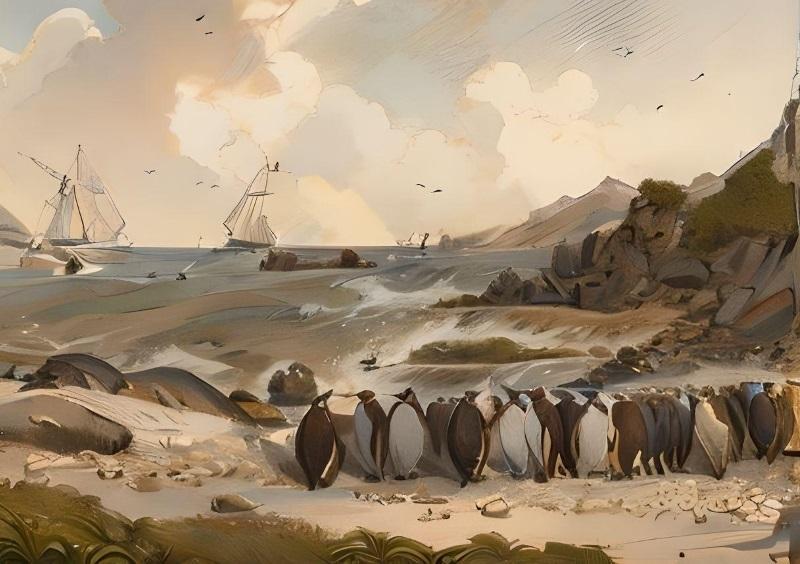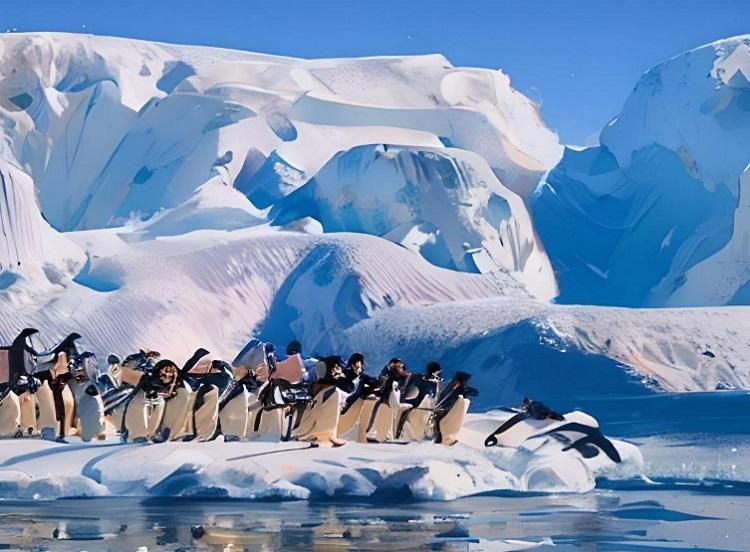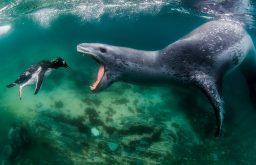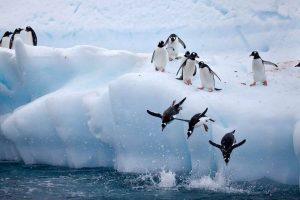
The first one among the first
In July 1819, two Russian sloops of war, Vostok and Mirny, set off from Kronstadt on the First Antarctic expedition. The task of the campaign was to prove or disprove the existence of Antarctica. Thaddeus Bellingshausen (1778-1852) led the expedition, he was also the captain of the Vostok. The Mirny was commanded by Mikhail Lazarev (1788-1851).
A total of 190 people took part in the expedition.On January 27, 1820, according to the new style, the ships crossed the Southern Arctic Circle, and the next day Bellingshausen wrote in his diary: “Continuing our journey south, at noon in latitude 69°21’28”, longitude 2°14’50” we met ice, which appeared to us through the snow in the form of white clouds.”
From Lazarev’s sloop, the picture that opened up was seen more clearly: “We met solid ice of extreme height… it stretched as far as the eye could reach.” These lines of the captains became the first description of Antarctica.
In February 1821, the Kazan Bulletin magazine published excerpts from letters from Ivan Simonov, a participant in the First Russian Antarctic Expedition. From a young age, the future astronomer Ivan Simonov (1794-1855) began to show extraordinary abilities in science. Already at the age of 18, he received a master’s degree in physics and Mathematics, and at the age of 22 he headed two astronomical departments of Kazan University at once.
At the age of 25, Professor Simonov, together with Bellingshausen and Lazarev, admired the Antarctic ice shelf twice. Being the only scientist in the team, Simonov conducted geographical, meteorological, ethnographic, zoological observations. He was the first Russian astronomer to study the stars of the Southern Hemisphere, which are never visible in Russia. Simonov also established for the first time that the south magnetic pole of the Earth at that time was located at 76° south and 142.5° east.
Simonov’s manuscript “Vostok” and “Mirny”, a travel diary of the expedition published by the university in 1990, is especially appreciated. Not only natural scientists are interested in him, but also literary critics: the manuscript is written in impeccable literary language. In addition to his penchant for science, Simonov had a talent for writing – the researcher himself admitted that in his youth he dreamed of listening to lectures at the Faculty of Verbal Sciences.
The man and the steamer

The sea off the coast of Antarctica and the glacier on Queen Maud Land, south of the Novolazarevskaya station, are named after this man. And there is also the minor planet 3334 and a research vessel that still plows the expanses of the polar seas. This man is the famous Soviet oceanologist, polar explorer, member of the Russian Geographical Society Mikhail Somov (1908-1973).
His expedition life began in 1938, when, as an employee of the Central Institute of Forecasts, he took part in ice exploration flights and tracked their movement. During the war, Mikhail Somov laid routes for our ships in the ice. In August 1942, he participated in the heroic defense of the village of Dixon and the research station located there, the capture of which would “give” the Germans access to the routes of ships along the Northern Sea Route.
In 1955-1957 Mikhail Somov led the First Soviet Antarctic expedition. Its result was the appearance of three polar stations at once. In February 1956, Mirny was established, the first Soviet scientific observatory in Antarctica. In May 1956, the opening of the Pionerskaya station took place, and in October – the Oasis on the shore of Lake Figurehead.
Somov has visited the sixth continent more than once. He led the Eighth and Ninth Antarctic Expeditions. He became a legend during his lifetime. The traditions he laid down in the profession of a polar scientist live to this day, and his achievements in the study of the Arctic and Antarctic were highly noted not only in Soviet Russia, but also abroad. The Royal Swedish Society of Anthropology and Geography awarded him the Vega Medal, and the British Geographical Society awarded him its gold medal.
Antarctic Chief
Novolazarevskaya station. It was here in April 1961, in order to avoid peritonitis and not to tempt fate while waiting for help from Mirny, doctor Leonid Rogozov removed his appendix to himself. Fortunately, the operation was successful: a week later, the surgeon had already removed the stitches and resumed his duties. Until the end of the year, he worked at the station not only as a doctor, but also as a meteorologist and even as a driver. But if something had happened to Rogozov, his father, the station chief, polar explorer Vladislav Gerbovich (1927-2004), would have had a hard time.
Novolazarevskaya became the successor of one of the three scientific stations operating during the Sixth Soviet Antarctic Expedition (1960-1962). Mirny and Lazarev were located near the ocean, Vostok was located at the south pole of inaccessibility. But the Lazarev station was located on the edge of the ice shelf: scientists feared that it could be carried into the ocean. It was decided to preserve the station, and instead open a new one – 100 km from the coast, near the Schirmacher oasis.
Vladislav Gerbovich was commissioned to find a place and build it. He was a tall man with a classic build and handsome features. A natural leader who had the gift of dragging people along. But he and his team had a hard time: the body was tired from heavy loads, under the rays of the Antarctic sun, the skin was instantly burned, the lips cracked in the cold so that it was difficult to smile.
And all this in conditions of a strict daily routine and with the threat of floods, which, as it turned out, also happen in Antarctica. Thanks to his fortitude, Gerbovich not only managed to maintain the fighting spirit and enthusiasm of his fellow comrades, but also did not give up himself in the harsh Antarctic conditions.
The official opening of Novolazarevskaya took place on February 18, 1961. After that, Vladislav Gerobovich more than once became the head of the polar stations and the whole wintering staff. His name was often heard in articles by journalists, on radio, on television, when it came to Antarctica, he became the hero of Vladimir Sanin’s adventure stories.
To Antarctica in any capacity

In 1966, the first of two volumes of the Antarctic atlas was published. The publication summarized the most important results of Soviet Antarctic research. It includes the most detailed description of the nature of Antarctica and the adjacent oceans. The editor-in–chief of the atlas was the Soviet oceanologist, geographer, since 1964 vice-president, and from 1977 to 1991 – President of the Geographical Society of the USSR, Arctic and Antarctic researcher Alexei Treshnikov (1914-1991).
He himself went to surf the expanses of the sixth continent more than once, with a total of 22 expeditions to both poles of the earth on his account. They seemed to beckon the scientist, although Treshnikov, while on expeditions, more than once found himself on the brink of death. “When he was offered to lead an expedition to Antarctica, he immediately ran to the post office and beat off the telegram: “I agree to go to Antarctica in any capacity,” recalls Alexey Treshnikov’s son–in-law Yevgeny Kasatkin.
He was trained to work in the field of geography of the polar countries by the outstanding oceanographer and cartographer Yuri Shokalsky. As a student of the Geological, Soil and Geographical Faculty of Leningrad University, Treshnikov made his first Arctic voyage, and in 1954 he headed the North Pole-3 drifting station. Antarctica, along with the Arctic, has become an integral part of Alexey Treshnikov’s life.
In 1956-1958, he became the head of the Second Soviet Antarctic Expedition, founded the Vostok and Komsomolskaya stations, in 1963 he participated in the creation of the Molodezhnaya, and in 1967 he led the 13th expedition to Antarctica, at the same time circumnavigating the world in high latitudes.
Treshnikov’s fourth Antarctic voyage took place in 1973. This time, the researcher became a participant in the rescue operation: the diesel-electric ship Ob was trapped by ice in the coastal zone near the mainland, and Alexey Fedorovich led the work on removing the vessel from ice captivity.
The man is a record
In his youth, Artur Chilingarov did not plan to become a polar explorer. Having decided to connect his life with the sea, he applied to the Admiral Makarov Higher Naval School, but did not pass the competition for the prestigious mechanical faculty. Then the head of the school, Vladimir Koshkin, suggested Chilingarov to transfer to the Arctic faculty, where there was a shortage.
“In a sinking voice, I asked Koshkin what kind of faculty it was, and he replied that he had graduated from it himself and did not regret it at all. I said: “Enroll! In the worst case, I will be the head of the school,” recalls Artur Nikolaevich. This is how the story of one of the outstanding Russian polar explorers began spontaneously.
It is difficult to count all the merits of Artur Chilingarov. He served as the head of the Bellingshausen station of the 17th Soviet Antarctic Expedition, led a special expedition to rescue the scientific expedition vessel Mikhail Somov, which was trapped in ice captivity in the Southern Ocean near the Russian station.
Chilingarov returned from this expedition as a Hero of the Soviet Union. And later he became a hero of Russia. And all this is just the tip of the iceberg. Artur Chilingarov became the first person in the world to visit the South and North Poles within six months. For this, his name is listed in the Guinness Book of Records.
By Asya Starodubtseva
More amazing facts about Antarctica can be found here.


